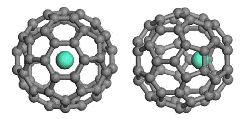Chemistry, Department of: Faculty Series

Xiao Cheng Zeng Publications
Document Type
Article
Date of this Version
9-22-2003
Abstract
Molecular dynamics simulation has been performed to study the effect of the polarizabilities of model anions on the ionic solvation in water clusters. The primary focus is given to the surface versus interior solvation behavior of the anions. To this end, various combinations of polarizable/nonpolarizable water and anion models were considered. Using the nonpolarizable TIP4P water with polarizable Cl2 and Br2 models, the Cl2 is fully solvated inside the (H2O) 60 cluster, whereas the Br2 is partially solvated at the surface of the cluster. However, when the polarizability of the Br2 is turned off, the “Br2” anion is fully solvated. Using the polarizable Dang–Chang water, both Cl2 and Br2 reside at the surface of (H2O) 60 as well as (H2O) 500 clusters, consistent with the finding of Stuart and Berne [J. Phys. Chem. 100, 11934 (1996)] based on the polarizable TIP4P-FQ water with the polarizable Drude halide model. When the polarizabilities of the halide anions are turned off, the smaller size “Cl2” anion is fully solvated in the interior of the Dang–Chang water cluster, whereas the larger “Br2” anion is still partially solvated at the surface of the cluster, indicating the importance of the anion-size effect. We have also calculated the free energy change for the Cl2 moving from the center of a lamella water slab to the surface. The free-energy change is on the order of 1 kcal/mol, indicating that the Cl2 can easily access the surface region of the Dang–Chang water slab.


Comments
Published by American Institute of Physics. J. Chem. Physics VOLUME 119, NUMBER 12, 22 SEPTEMBER 2003. ©2003 American Institute of Physics. Permission to use. http://jcp.aip.org/.